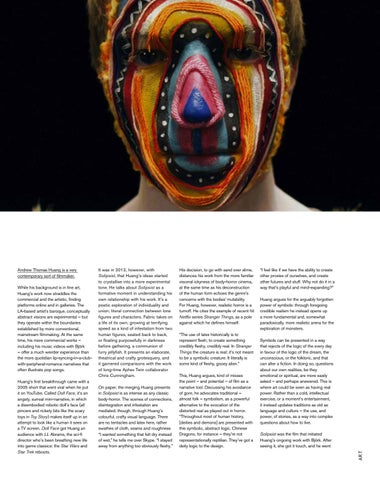While his background is in fine art, Huang’s work now straddles the commercial and the artistic, finding platforms online and in galleries. The LA-based artist's baroque, conceptually abstract visions are experimental – but they operate within the boundaries established by more conventional, mainstream filmmaking. At the same time, his more commercial works – including his music videos with Björk – offer a much weirder experience than the more quotidian lip-syncing-in-a-clubwith-peripheral-romance narratives that often illustrate pop songs. Huang’s first breakthrough came with a 2005 short that went viral when he put it on YouTube. Called Doll Face, it’s an angsty, surreal mini-narrative, in which a disembodied robotic doll’s face (all pincers and rickety bits like the scary toys in Toy Story) makes itself up in an attempt to look like a human it sees on a TV screen. Doll Face got Huang an audience with J.J. Abrams, the sci-fi director who’s been breathing new life into genre classics: the Star Wars and Star Trek reboots.
It was in 2012, however, with Solipsist, that Huang’s ideas started to crystallise into a more experimental tone. He talks about Solipsist as a formative moment in understanding his own relationship with his work. It’s a poetic exploration of individuality and union; literal connection between lone figures and characters. Fabric takes on a life of its own; growing at terrifying speed as a kind of infestation from two human figures, seated back to back, or floating purposefully in darkness before gathering, a communion of furry jellyfish. It presents an elaborate, theatrical and crafty grotesquery, and it garnered comparisons with the work of long-time Aphex Twin collaborator Chris Cunningham. On paper, the merging Huang presents in Solipsist is as intense as any classic body-horror. The scenes of connections, disintegration and infestation are mediated, though, through Huang’s colourful, crafty visual language. There are no tentacles and latex here, rather swathes of cloth, seams and roughness “I wanted something that felt dry instead of wet,” he tells me over Skype. “I stayed away from anything too obviously fleshy.”
His decision, to go with sand over slime, distances his work from the more familiar visceral ickyness of body-horror cinema, at the same time as his deconstruction of the human form echoes the genre’s concerns with the bodies’ mutability. For Huang, however, realistic horror is a turnoff. He cites the example of recent hit Netflix series Stranger Things, as a pole against which he defines himself. “The use of latex historically is to represent flesh; to create something credibly fleshy, credibly real. In Stranger Things the creature is real; it’s not meant to be a symbolic creature. It literally is some kind of fleshy, gooey alien.” This, Huang argues, kind of misses the point – and potential – of film as a narrative tool. Discussing his avoidance of gore, he advocates traditional – almost folk – symbolism, as a powerful alternative to the evocation of the distorted real as played out in horror. “Throughout most of human history, [deities and demons] are presented with this symbolic, abstract logic. Chinese Dragons, for instance – they’re not representationally reptilian. They’ve got a deity logic to the design.
“I feel like if we have the ability to create other proxies of ourselves, and create other futures and stuff. Why not do it in a way that’s playful and mind-expanding?” Huang argues for the arguably forgotten power of symbols: through foregoing credible realism he instead opens up a more fundamental and, somewhat paradoxically, more realistic arena for the exploration of monsters. Symbols can be presented in a way that rejects of the logic of the every day in favour of the logic of the dream, the unconscious, or the folkloric, and that can alter a fiction. In doing so, questions about our own realities, be they emotional or spiritual, are more easily asked – and perhaps answered. This is where art could be seen as having real power. Rather than a cold, intellectual exercise, or a moment’s entertainment, it instead updates traditions as old as language and culture – the use, and power, of stories, as a way into complex questions about how to live. Solipsist was the film that initiated Huang’s ongoing work with Björk. After seeing it, she got it touch, and he went
ART
Andrew Thomas Huang is a very contemporary sort of filmmaker.
